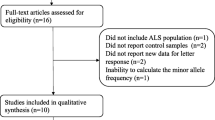Abstract
Amyotrophic lateral sclerosis (ALS) is a progressive disorder involving the degeneration of motor neurons. ALS shares pathogenic characteristics and genetic risk factors with multiple system atrophy (MSA). Here we examine whether a variant of the COQ2 gene associated with MSA in Japanese is also associated with ALS in Han Chinese. The ligase detection reaction was used to measure the frequency of the V393A variant of COQ2 in 282 patients with ALS and 491 healthy controls. The ALS and control groups showed no significant differences in genotype frequencies (OR 1.298, 95 %CI 0.396–4.253, p = 0.666) or allele frequencies (OR 1.314, 95 %CI 0.403–4.286, p = 0.650) at the V393A locus of COQ2. We also conducted a meta-analysis and combined our data with the previous Japanese research, but still failed to detect an association between V393A and ALS. In conclusion, This case–control study shows no evidence for an association between ALS and the V393A variant of COQ2 in Han Chinese and together with the Japanese research suggests that this polymorphism may not be linked to the risk of ALS in East Asians in general.
Similar content being viewed by others
References
Rowland LP, Shneider NA (2001) Amyotrophic lateral sclerosis. N Engl J Med 344(22):1688–1700
Kamel F, Umbach DM, Munsat TL et al (2002) Lead exposure and amyotrophic sclerosis. Epidemiology 13(3):311–319
ArmonC KurlandLT, Daube JR et al (1991) Epidemiologic correlates of sporadic amyotrophic lateral sclerosis. Neurology. 41(7):1077–1084
Yu Y, Su F-C, Callaghan BC et al (2014) Environmental risk factors and amyotrophic lateral sclerosis (ALS): a case–control study of ALS in Michigan. PLoS ONE 9:e101186
Andersen PM (2006) Amyotrophic lateral sclerosis associated with mutations in the CuZn superoxide dismutase gene. Curr Neurol Neurosci Rep 6(1):37–46
Sreedharan J, Blair IP, Tripathi VB et al (2008) TDP-43 mutations in familial and sporadic amyotrophic lateral sclerosis. Science 319(5870):1668–1672
Kwiatkowski TJ Jr, Bosco DA, Leclerc AL et al (2009) Mutations in the FUS/TLS gene on chromosome 16 cause familial amyotrophic lateral sclerosis. Science 323(5918):1205–1208
Chiò A, Schymick JC, Restagno G et al (2009) A two-stage genome-wide association study of sporadic amyotrophic lateral sclerosis. Hun Mol Genet 18(8):1524–1532
Kwee LC, Liu Y, Haynes C et al (2012) A high-density genome-wide association screen of sporadic ALS in US veterans. PLoS One 7:e32768
Fogh I, D’Alfonso S, Gellera C et al (2011) No association of DPP6 with amyotrophic lateral sclerosis in an Italian population. Neurobio Aging 32(5):966–967
Daoud H, Belzil V, Desjarlais A et al (2010) Analysis of the UNC13A gene as a risk factor for sporadic amyotrophic lateral sclerosis. Arch Neurol 67(4):516–517
He X, Zhang L, Yao X et al (2013) Association studies of MMP-9 in Parkinson’s disease and amyotrophic lateral sclerosis. PLoS One 8:e73777
Deng M, Wei L, Zuo X et al (2013) Genome-wide association analyses in Han Chinese identify two new susceptibility loci for amyotrophic lateral sclerosis. Nat Genet 45(6):697–700
Gilbert RM, Fahn S, Mitsumoto H et al (2010) Parkinsonism and motor neuron diseases: twenty-seven patients with diverse overlap syndromes. Mov Disord 25(12):1868–1875
Sakamoto H, Akamatsu M, Hirano M et al (2014) Multiple system involvement in a Japanese patient with a V31A mutation in the SOD1 gene. Amyotroph Lateral Scler Frontotemporal Degener 15(3–4):312–314
Fujioka S, Ogaki K, Tacik PM et al (2014) Update on novel familial forms of Parkinson’s disease and multiple system atrophy. Parkinsonism Relat Disord 20(Suppl 1):S29–S34
Multiple-System Atrophy Research Collaboration (2013) Mutations in COQ2 in familial and sporadic multiple-system atrophy. N Engl J Med 369(3):233–244
Palma JA, Kaufmann H (2014) Novel therapeutic approaches in multiple system atrophy. Clin Auton Res. doi:10.1007/s10286-014-0249-7
Thomas G, Sinville R, Sutton S et al (2004) Capillary and microelectrophoretic separations of ligase detection reaction products produced from low-abundant point mutations in genomic DNA. Electrophoresis 25(10–11):1668–1677
Guo XY, Chen YP, Song W et al (2014) An association analysis of the rs1572931 polymorphism of the RAB7L1 gene in Parkinson’s disease, amyotrophic lateral sclerosis and multiple system atrophy in China. Eur J Neurol 21(10):1337–1343
Ticozzi N, Tiloca C, Calini D et al (2014) C9orf72 repeat expansions are restricted to the ALS-FTD spectrum. Neurobiol Aging 35(4):936.e13-7
Acknowledgments
This research was supported by the National Natural Science Foundation of China (No. 81471300), the Sichuan Province Applied Basic Research Program (No. 2014JY0247), the Sichuan Key Project of Science and Technology (No. 2010SZ0086) and the Ministry of Science and Technology of China (2012AA02A514). We thank all the patients and controls involved in this research.
Conflict of interest
The authors declare no conflicts of interest.
Author information
Authors and Affiliations
Corresponding author
Additional information
X. Yang, J. Xi and R. An contributed equally to this work.
Rights and permissions
About this article
Cite this article
Yang, X., Xi, J., An, R. et al. Lack of evidence for an association between the V393A variant of COQ2 and amyotrophic lateral sclerosis in a Han Chinese population. Neurol Sci 36, 1211–1215 (2015). https://doi.org/10.1007/s10072-015-2083-7
Received:
Accepted:
Published:
Issue Date:
DOI: https://doi.org/10.1007/s10072-015-2083-7




